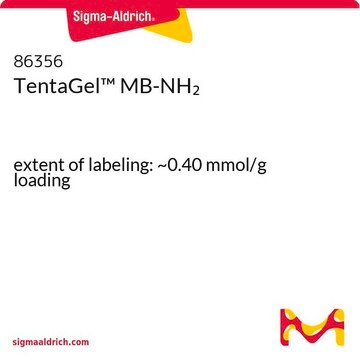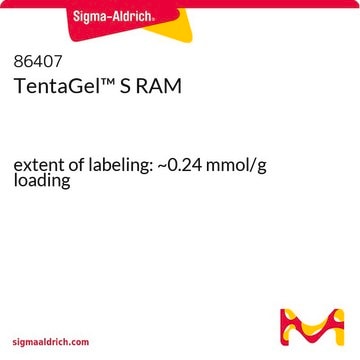91924
Tentagel™ M OH Microspheres
extent of labeling: ~0.2 mmol/g loading
Synonim(y):
O-(2-Hydroxyethyl)polyethylene glycol grafted to polystyrene
Zaloguj sięWyświetlanie cen organizacyjnych i kontraktowych
About This Item
Kod UNSPSC:
12352200
NACRES:
NA.25
Polecane produkty
Postać
powder
zakres etykietowania
~0.2 mmol/g loading
wielkość cząstki
10 μm
temp. przechowywania
2-8°C
Zastosowanie
Tentagel beads are functionalized polystyrene-polyethylene glycol (PS-PEG) beads that may be used in the development of combinatorial libraries for high throughput analysis.
Informacje prawne
TentaGel is a trademark of Rapp Polymere GmbH
This page may contain text that has been machine translated.
Kod klasy składowania
13 - Non Combustible Solids
Klasa zagrożenia wodnego (WGK)
WGK 3
Temperatura zapłonu (°F)
Not applicable
Temperatura zapłonu (°C)
Not applicable
Środki ochrony indywidualnej
Eyeshields, Gloves, type N95 (US)
Certyfikaty analizy (CoA)
Poszukaj Certyfikaty analizy (CoA), wpisując numer partii/serii produktów. Numery serii i partii można znaleźć na etykiecie produktu po słowach „seria” lub „partia”.
Masz już ten produkt?
Dokumenty związane z niedawno zakupionymi produktami zostały zamieszczone w Bibliotece dokumentów.
H Weinberger et al.
Archiv der Pharmazie, 330(4), 109-111 (1997-04-01)
Peptides from small combinatorial libraries, covalently attached to polymeric TentaGel beads, can be directly sequenced using amino acid analysis. For libraries with restricted diversity, generated by the split-mix synthesis method, the amino acids on a selected single bead identified by
Gary L Juskowiak et al.
Journal of combinatorial chemistry, 10(5), 726-731 (2008-07-29)
Cysteine-rich peptides are valued as tags for biarsenical fluorophores and as environmentally important reagents for binding toxic heavy metals. Due to the inherent difficulties created by cysteine, the power of one-bead one-compound (OBOC) libraries has never been applied to the
Hyoung Gee Baek et al.
Journal of combinatorial chemistry, 11(1), 91-102 (2008-12-09)
The one-bead one-compound (OBOC) combinatorial library method enables the rapid generation and screening of millions of discrete chemical compounds on beads. Most of the OBOC screening methods require the library compounds to remain tethered to the bead during screening process.
Nasz zespół naukowców ma doświadczenie we wszystkich obszarach badań, w tym w naukach przyrodniczych, materiałoznawstwie, syntezie chemicznej, chromatografii, analityce i wielu innych dziedzinach.
Skontaktuj się z zespołem ds. pomocy technicznej







